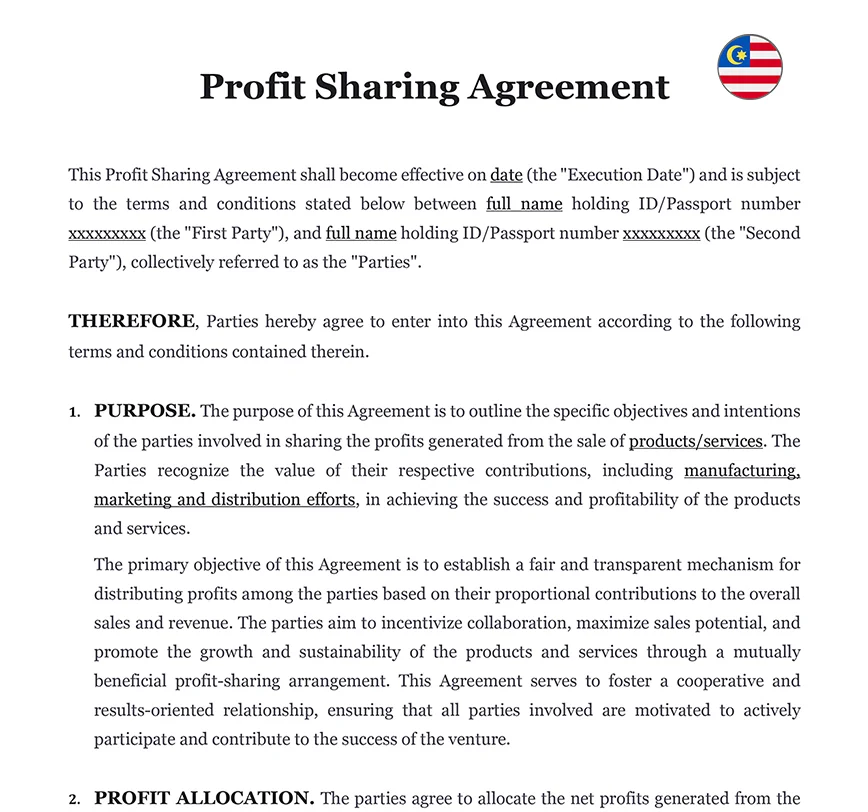Ready to use legal template
Drafted by experienced lawyers
Compliant with Malaysian law
Ready to use legal template
Drafted by lawyers
Compliant with Malaysian law
Home › Business contracts › Profit Sharing Agreement
Learn more about Profit Sharing Agreement in Malaysia
A profit-sharing agreement is a formal arrangement between a company and its employees or shareholders that outlines how the profits of the business will be distributed among the parties involved. In this agreement, the company agrees to share a portion of its profits with the designated individuals or groups based on predetermined terms and conditions. The profit-sharing agreement defines the percentage or formula used to calculate the distribution of profits and establishes the frequency at which the payouts will occur. Themis Partner offers you an easy to edit Profit Sharing Agreement drafted by lawyers to comply with the law in Malaysia.
Table of contents
What is a Profit Sharing Agreement?
A profit sharing agreement is a contractual arrangement between a company and its employees that establishes the terms and conditions for distributing a portion of the company’s profits among eligible employees. It serves as a mechanism to reward and incentivise employees based on the company’s financial performance. In the agreement, the specific formula or methodology for calculating and allocating profits is outlined, taking into consideration factors such as individual or team performance, tenure, or a predetermined percentage. This agreement is designed to align the interests of employees with those of the company, fostering a sense of ownership, motivation, and engagement among the workforce. By linking financial rewards to the company’s success, it can promote a collaborative and results-oriented culture within the organization.
Why use a Profit Sharing Agreement?
The agreement is utilised for several reasons, primarily to foster a sense of shared success and align the interests of employees with the overall performance of the company. By implementing an agreement, organizations can create a powerful incentive structure that motivates employees to contribute their best efforts towards achieving the company’s goals. It can promote teamwork, collaboration, and a collective sense of responsibility among employees, as they recognise that their individual contributions directly impact the company’s profitability and, subsequently, their own financial rewards. Furthermore, it can help attract and retain talented individuals by offering them a stake in the company’s success. This can enhance employee loyalty and reduce turnover rates, as employees feel valued and financially invested in the organization’s growth. Overall, the agreement can be an effective tool to drive employee engagement, enhance productivity, and foster a positive and performance-driven work environment.
What should a Profit Sharing Agreement include?
1. Eligibility criteria
Clearly define which employees are eligible to participate in the profit sharing program, such as full-time or part-time employees, specific job roles, or length of service requirements.
2. Profit calculation methodology
Specify the formula or method used to calculate the company’s profits, which will serve as the basis for determining the distribution of funds.
3. Allocation criteria
Outline how the profits will be allocated among eligible employees, whether it’s based on individual performance, team performance, a fixed percentage, or another predetermined criterion. You may use an Employee Performance Evaluation for this.
4. Timing and frequency
Indicate when and how often the profit sharing payments will be made, such as annually, quarterly, or at the end of each financial period.
5. Terms and conditions
Include any conditions or requirements for employees to be eligible for the profit sharing program, such as maintaining employment throughout the year or meeting certain performance targets.
6. Discretionary provisions
Specify whether the company has the discretion to adjust or withhold profit sharing payments based on exceptional circumstances or unforeseen events.
7. Communication and transparency
Emphasise the importance of transparency in communicating profit sharing results to employees, ensuring they understand the calculation process and how their individual contributions impact the overall distribution.
8. Termination or amendment clause
Address the circumstances under which the profit sharing agreement can be modified or terminated, and the process for making any changes.
9. Legal and regulatory compliance
Ensure that the agreement complies with applicable laws, regulations, and tax requirements.
10. Confidentiality
Include provisions to maintain the confidentiality of financial information and protect sensitive data related to profit sharing calculations.
ℹ️ It’s important to note that a legal professional should review and customise the profit sharing agreement based on the specific needs and requirements of the organisation.
How to distribute profits?
When determining how to distribute profits, several factors come into play, including the Shareholders’ Agreement and Share Purchase Agreement. Here are some common methods of distributing profits:
1. Dividends: The shareholders’ agreement typically governs the distribution of profits to shareholders in the form of dividends. Dividends can be paid out in proportion to each shareholder’s ownership stake, as specified in the agreement.
2. Capital appreciation: If the share purchase agreement includes provisions for capital appreciation, profits can be distributed through the sale of shares at a higher price than the initial purchase price. Shareholders may realise profits by selling their shares to other parties or through a buyback arrangement facilitated by the company.
3. Bonus shares: Instead of distributing profits as cash dividends, the company may issue additional shares to existing shareholders in proportion to their current holdings. This method allows shareholders to increase their ownership percentage in the company without requiring immediate cash payouts.
4. Stock options or equity-based incentives: Under the shareholders’ agreement or separate equity incentive plans, the company may distribute profits by granting stock options or other equity-based incentives to employees or key stakeholders. This aligns their interests with the company’s performance and may allow them to benefit from future appreciation in share value.
ℹ️ It is important to note that the specific method of profit distribution will depend on the terms and provisions outlined in the shareholders’ agreement and share purchase agreement. These agreements play a crucial role in defining the rights and obligations of shareholders, including the distribution of profits and the mechanisms for realising gains from share ownership.
What if I don’t have a Profit Sharing Agreement?
If you don’t have an agreement in place, the distribution of profits can become uncertain and potentially contentious. Without a clear framework to guide profit allocation, disputes may arise among partners or stakeholders regarding how profits should be divided. In the absence of a profit sharing agreement, the default provisions of the Partnership Agreement, if applicable, may come into play. However, the partnership agreement may not specifically address profit sharing or may have limited provisions on the matter. This ambiguity can lead to disagreements, confusion, and even damage the relationships between partners. Therefore, it is crucial to establish a comprehensive agreement that outlines the criteria, methods, and conditions for profit distribution, ensuring transparency, fairness, and the smooth functioning of the partnership.
What considerations should be taken into account?
Several considerations should be taken into account when establishing an agreement.
| ➤ First and foremost, it is important to clearly define the goals and objectives of the profit sharing program. Consider whether the primary focus is to reward individual performance, encourage team collaboration, or align employee interests with the overall success of the company. |
| ➤ Additionally, factors such as the financial stability and profitability of the organization should be considered to ensure the feasibility of profit sharing. Determining the appropriate distribution formula or methodology is crucial, taking into account variables such as tenure, job role, or individual performance. |
| ➤ It is also important to establish eligibility criteria and set clear expectations for employees regarding their participation in the profit sharing program. Legal and regulatory compliance should be carefully examined to ensure adherence to relevant laws, tax regulations, and any contractual obligations. |
| ➤ Finally, fostering transparency and effective communication with employees is vital, as it promotes understanding, trust, and engagement in the profit sharing process. |




